Middle East
-
- Middle East Liner Trades — An Economic Analysis Maritime Reporter, Aug 15, 1978 #42
Liner shipping to the Middle East has gone through a succession of fundamental changes since 1973. The tremendous boom in traffic which followed the oil price rise could not be accommodated by existing ports in the region and, as a result, congestion rose to unprecedented levels. Freight rates also soared. A variety of measures were introduced to combat this situation. In shipping, the first significant move was the switching of ro/ro ferries from their traditional short-sea routes (in the North Sea and elsewhere) to deepsea Middle East trades.
Port congestion, which reached horrendous levels in 1975-76, has since disappeared much f a s t e r than many people had anticipated.
This can be ascribed to a combination of "congestion-beater" services (ro/ro and other), the opening of new berths, the introduction of expatriate port management and a range of strong local initiatives. Additionally, the c o n t r i b u t i o n of slower traffic growth should not be ignored.
Looking ahead over the next few years, some important changes in seaborne traffic to the Middle East can be anticipated. The initial boom in imports which followed the 1973 oil price rise has now subsided in most states, with import growth falling back to more sustainable levels. Focusing on the liner sector, it seems likely that declining imports of building materials and steel products (due to peaking of construction activity and increased local steel production) and of manufactured fertilizers (again, due to increased local production) will offset in tonnage terms continued growth in demand for foodstuffs, machinery and transport equipment and consumer goods over the next few years. In the longer term, despite efforts to develop general manufacturing industries and step up local food production, the forces for growth should reassert themselves.
On the basis of a 4 percent per annum growth in liner traffic to ports in the Arabian Peninsula and Iran in the early 1980s, liner traffic to this area would reach 32 million tons in 1980 and 39 million tons in 1985, compared with an estimated 31 million tons in 1977 and 25 million tons in 1976.
These statistics are taken from "Middle East Liner Shipping: An Economic A n a l y s i s of Traffic, Services, Ports and Future Prospects," the latest in a long line of reports from HPD Shipping Publications.
Although the boom in liner traffic has eased recently, new services have continued to enter Middle East trades at a rapid rate.
With the decline in vessel waiting times, conventional liner tonnage is re-emerging as a major force.
In addition to ro/ro services, large numbers of small, geared cellular vessels have been introduced by operators since 1976, and with new, gantry-equipped container terminals opening up, g e a r l e s s containerships are also beginning to appear. On top of this, there is a noticeable trend toward larger vessels, offering scope for cost savings through scale economies. Add to all this LASH vessels, towed barge systems and hybrid vessels (such as the "Strider" class), and the variety of shipping types competing on Middle East routes can be seen to exceed that of any other major liner trade.
By summer 1977, capacity on ro/ro and container services into the Middle East had reached an estimated 35,000 TEU per month, with 25,000 TEU to the Gulf and around 10,000 TEU to Red Sea ports. Of the Gulf capacity, some 19,000 TEU was being provided by geared containerships, with ro/ro-based tonnage accounting for most of the remainder. In the Red Sea, unitized traffic was l a r g e l y rolling in either pure ro/ros, ro/ro container hybrids (with ro/ro access but cellular stowage) or towed barges (with ro/ro access and stowage). By March 1978, unitized capacity on Middle East routes had risen to an estimated 58,000 TEU per month, with container services accounting for 39,000 TEU and ro/robased services for an estimated 19,000 TEU.
H.P. Drewry calculations suggest that average load factors on Middle East routes have declined over the past year. Other evidence —a fall in freight rates, the financial difficulties of some operators and "rationalization" of services —supports the view that these trades are overtonnaged at present.
There would seem to be little prospect of any rapid improvement in fortunes. A significant number of container, ro/ro and even conventional vessels are on order for Middle East routes, and several new services have been announced in recent months, principally from the Far East and Australia. It may be several years before the further penetration of unitization boosts container and ro/ro traffic sufficiently to absorb the surplus unitized tonnage. An anticipated absolute decline in conventional liner traffic will tend to maintain excess capacity in this sector, even though only limited additions to the range of conventional services on offer are forseen.
As regards the ports, the programs of massive development, spurred on by the post-1973 traf- fic boom and surge in oil revenues, played only a minor role in the easing of congestion—most of this new development is still "in the pipeline." As with shipping, there are considerable fears of overcapacity.
The new HPD survey reveals that the number of conventional general cargo berths (with depths of water of 8 meters or more) at ports in the region rose from 97 in 1973 to 176 by end- 1976 and is scheduled to reach an astonishing 484 by the end of 1983. The first two containerro/ ro berths were designated in 1976; by end-1977, there were 18 such berths. The number of such facilities may reach 74 by end- 1983. Comparison of projected port capacity with projected traffic clearly reveals the prospect of a major overprovision of both conventional and unitized facilities at Middle East ports in the early 1980s. Port authorities in general will be unable to cover the capital and operating costs of their new berths, given the low levels of utilization expected, and a substantial element of subsidy in tariffs seems inevitable. This may well affect the competitive position of different vessel types and may favor those (such as gear less containerships) which are heavily dependent on expensive port facilities.
Port overcapacity may also reinforce overtonnaging in shipping, by making it easier for operators to introduce additional sailings or new services, should the market begin to show signs of improvement.
In addition to quantifying the growth of Middle East liner shipping and port facilities, and comparing capacity in both sectors with volumes of traffic, "Middle East Liner Shipping" contains quay-to-quay per cargo ton cost comparisons for different sizes and types of liner vessel (conventional, cellular, ro/ro, etc.) on Middle East routes. An assessment is made of which types of service, and which types of operator, are most likely to survive and ultimately prosper in these now highly competitive trades.
"Middle East Liner Shipping: An Economic Analysis of Traffic, Services, Ports and Future Prospects," priced at U.S. $160 for all overseas orders or £75 for U.K.
orders, is available from HPD Shipping Publications, 34, Brook Street, Mayfair, London W1Y 2LL, England.
-
- DeLaval Appoints Foltz General Manager For Middle East Maritime Reporter, Mar 1978 #44
E.B. Koelliker, vice president, DeLaval Turbine Inc., has announced the appointment of Arthur L. FoltZ Jr. as general manager, Middle East. Mr. Foltz will be based at De- Laval's Middle East Headquarters in Riyadh, Saudi Arabia, where they have a sales and service organization, and are planning
-
- Seaward To Supply Buoys For Middle East Jackups —Literature Available Maritime Reporter, Mar 1983 #62
, Inc., Falls Church, Va., supplied 16 Sea Float pendant buoys to a worldwide drilling company for use on four jackup rigs scheduled for service in the Middle East. The buoys have a unique square cross section that minimizes the ADDRESShazard of their rolling around on the deck of the workboat during handli
-
- Halter Delivers Large Pilot Boat For Middle East Service Maritime Reporter, Feb 15, 1981 #14
Halter Marine, Inc., New Orleans, recently delivered the 87- foot pilot boat Elalat 9 to Marine and T r a n s p o r t a t i o n Services (Saudi), Ltd. The lightweight, steel-hull vessel will transport pilots and pollution-control authorities to and from oil tankers at the giant Sea Island petroleum p
-
- New Development Team For Ocean Liners Maritime Reporter, Apr 15, 1977 #6
is a director of the USA/West Africa trade. Mr. Miles will be responsible for the development of new business opportunities, principally in the Middle East and Nigeria. He will be assisted by a newly formed development team, which at present consists of P. Collins, T.G. Sawyer and J.C. Bishop. Mr
-
- US Boatbuilding: Exports Buoy Bottom Lines Maritime Logistics Professional, Q3 2016 #50
craft market. Acting not only as a balance against a waning domestic military small boat market, Vigor also sees potentially rich opportunities with Middle East entities who will likely see great need for this type of littoral craft in the future. This isn’t Vigor’s first export rodeo. Vigor has previously
-
- North America-Mideast Trade To Get Largest Ro/Ro Ships In New Seaspeed Service This Month Maritime Reporter, Apr 15, 1977 #14
and built for Seaspeed Services especially for this trade, will commence service from the Virginia port of Portsmouth and will call at the Middle East ports of Dammam, Dubai, Bandar Shahpour, and—in a later sailing —Jeddah. Seaspeed Services is already the largest carrier from Northern Europe
-
- GE Appoints Noonan Ma nager Of Marketing For Marine Gas Turbines Maritime Reporter, Jan 1977 #34
in GE's Industrial Gas Turbine Department. In Geneva, Nicholas Baker will continue as sales manager for marine gas turbines in Europe and the Middle East, and Gary Whalen will continue as sales manager for industrial applications in Europe. John Mann joined the company on December 1 as sales
-
- Crude Oil Supply And Tanker Demand Report Available From Drewry Maritime Reporter, Jan 15, 1980 #24
and of maximizing revenues in the long-term. In the wake of the Iranian Crisis, these ceilings have been strictly applied. Oil exports from the Middle East have for some years served to balance global supply and demand, but since 1973 the political and economic climate in the Middle East has changed
-
- McDermott Restructures O p e r a t i n g Unit Into Five A r e a s Of Responsibility Maritime Reporter, Mar 15, 1980 #14
., responsible for the Middle East and Southeast Asia areas. Mr. Davis joined the McDermott organization in 1969 as an operations engineer in the Middle East, becoming vice president of the Middle East operations in 1972, and Group vice president there in 1974. Since that time, he has been responsible
-
- Santa Fe Drilling Names Parry Manager All Drilling Rigs Maritime Reporter, Mar 1978 #26
manager. Promoted to vice president were C.L. Barnhill, London, area vice president, Europe and Africa ; J.H. Morris, Bahrain, area vice president, Middle East; B.G. Parker, Bahrain, vice president and operations manager, Middle East; E.D. Shepherd, Houston, area vice president, and R.E. Hinson, Orange
-
- Sources Of U.S. Oil Imports And U.S. Oil Companies' Role In The Mideast Maritime Reporter, Mar 1991 #48
from Saudia Arabia, and 1.2 percent from Kuwait. Small amounts also came from Oman, Qatar and the United Arab Emirates. OPEC nations outside the Middle East—Venezuela, Nigeria and four others—provided 29 percent. Canada, Mexico and other non-OPEC nations outside the Middle East supplied the remainder
-
 )
March 2024 - Marine Technology Reporter page: 45
)
March 2024 - Marine Technology Reporter page: 45ronments. The new agreement will address speci? c techni- cal gaps in the UUV defense and offshore energy markets especially for long duration, multi-payload mission opera- tions where communications are often denied or restricted. As part of the new alliance, Metron’s Resilient Mission Autonomy portfolio
-
 )
March 2024 - Marine Technology Reporter page: 33
)
March 2024 - Marine Technology Reporter page: 33regulated industry in the world.” How- ever, commercial success depends on many factors, not least a predictable OPEX. Over the past four years, SMD has worked with Oil States Industries to calculate cost per tonne ? gures for prospective customers. Patania II uses jet water pumps to Oil States’
-
 )
March 2024 - Marine Technology Reporter page: 4
)
March 2024 - Marine Technology Reporter page: 4Editorial NIWA-Nippon Foundation TESMaP/ Rebekah Parsons-King www.marinetechnologynews.com ast month marked the resounding NEW YORK 118 E. 25th St., New York, NY 10010 return of Oceanology Interna- Tel: (212) 477-6700; Fax: (212) 254-6271 tional in London, perennially one Lof the world’s most important
-
 )
April 2024 - Maritime Reporter and Engineering News page: 25
)
April 2024 - Maritime Reporter and Engineering News page: 25your ships. How can you keep your ships authority, also one of just a few within the Navy. We’re our manned and ready for sea? Our shortfall is in the middle to senior positions within our own manning control authority for our civil service mari- licensed mariners, but we need to attract the junior people
-
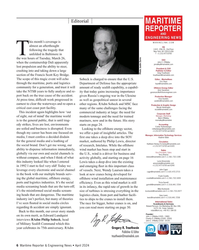 )
April 2024 - Maritime Reporter and Engineering News page: 6
)
April 2024 - Maritime Reporter and Engineering News page: 6Editorial MARITIME REPORTER AND ENGINEERING NEWS his month’s coverage is M A R I N E L I N K . C O M almost an afterthought HQ 118 E. 25th St., 2nd Floor following the tragedy that New York, NY 10010 USA T +1.212.477.6700 Tunfolded in Baltimore in the wee hours of Tuesday, March 26, CEO John C.
-
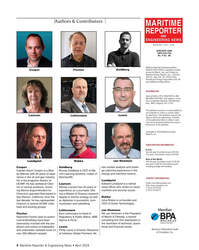 )
April 2024 - Maritime Reporter and Engineering News page: 4
)
April 2024 - Maritime Reporter and Engineering News page: 4Authors & Contributors MARITIME REPORTER AND ENGINEERING NEWS M A R I N E L I N K . C O M ISSN-0025-3448 USPS-016-750 No. 4 Vol. 86 Maritime Reporter/Engineering News (ISSN # 0025-3448) is published monthly Cooper Fischer Goldberg except for March, July, and October by Maritime Activity Reports, Inc.
-
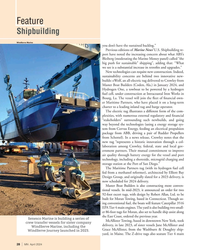 )
April 2024 - Marine News page: 28
)
April 2024 - Marine News page: 28Feature Shipbuilding WindServe Marine you don’t have the sustained backlog.” Previous editions of Marine News’ U.S. Shipbuilding re- port have noted the increasing concern about what ABS’s Bleiberg (moderating the Marine Money panel) called “the big push for sustainable” shipping”, adding that: “What we
-
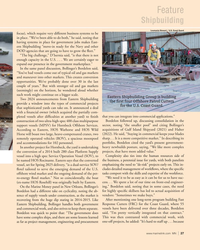 )
April 2024 - Marine News page: 27
)
April 2024 - Marine News page: 27Feature Shipbuilding Loumania Stewart / U.S. Coast Guard focus), which require very different business systems to be in place. “We’ve been able to do both,” he said, noting that having systems in place for government jobs makes East- ern Shipbuilding “move-in ready for the Navy and other DOD agencies
-
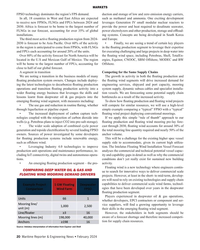 )
February 2024 - Maritime Reporter and Engineering News page: 20
)
February 2024 - Maritime Reporter and Engineering News page: 20MARKETS FPSO technology dominates the region’s FPS demand. duction and storage of low and zero emission energy carriers, In all, 18 countries in West and East Africa are expected such as methanol and ammonia. One exciting development to receive new FPSOs, FLNGs and FPUs between 2024 and leverages
-
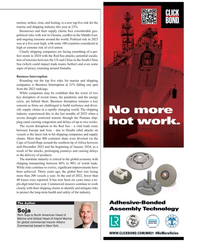 )
February 2024 - Maritime Reporter and Engineering News page: 13
)
February 2024 - Maritime Reporter and Engineering News page: 13and shipping industry this year at 23%. Businesses and their supply chains face considerable geo- political risks with war in Ukraine, con? ict in the Middle East, and ongoing tensions around the world. Political risk in 2023 was at a ? ve-year high, with some 100 countries considered at high or extreme
-
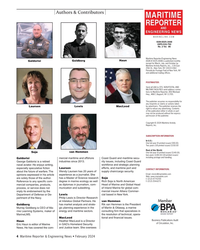 )
February 2024 - Maritime Reporter and Engineering News page: 4
)
February 2024 - Maritime Reporter and Engineering News page: 4Authors & Contributors MARITIME REPORTER AND ENGINEERING NEWS M A R I N E L I N K . C O M ISSN-0025-3448 USPS-016-750 No. 2 Vol. 86 Maritime Reporter/Engineering News Goldberg Haun (ISSN # 0025-3448) is published monthly Galdorisi except for March, July, and October by Maritime Activity Reports, Inc.
-
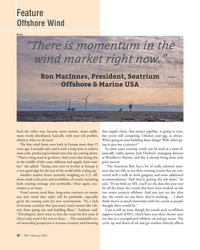 )
February 2024 - Marine News page: 30
)
February 2024 - Marine News page: 30Diedrich, managing director “That’s a long road to go down. And you’re also facing this at WindServe Marine, said this is already being done with in the middle of this crazy in? ation and supply chain mar- great success. ket,” she added. “Seeing costs start to levelize in Europe is “The American ? eet has
-
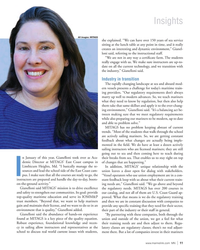 )
February 2024 - Marine News page: 11
)
February 2024 - Marine News page: 11Insights All images: MITAGS she explained. “We can have over 150 years of sea service sitting at the lunch table at any point in time, and it really creates an interesting and dynamic environment,” Gianel- loni said, referring to the instructional staff. “We are not in any way a certi? cate farm. The
-
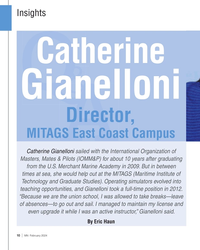 )
February 2024 - Marine News page: 10
)
February 2024 - Marine News page: 10Insights Catherine QQQQQQQQQAAA & Gianelloni Director, MITAGS East Coast Campus Catherine Gianelloni sailed with the International Organization of Masters, Mates & Pilots (IOMM&P) for about 10 years after graduating from the U.S. Merchant Marine Academy in 2009. But in between times at sea, she would
-
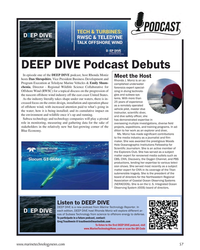 )
January 2024 - Marine Technology Reporter page: 57
)
January 2024 - Marine Technology Reporter page: 57DEEP DIVE Podcast Debuts In episode one of the DEEP DIVE podcast, host Rhonda Moniz Meet the Host hosts Dan Shropshire, Vice President Business Development and Rhonda J. Moniz is an ac- Program Execution at Teledyne Marine Vehicles & Emily Shum- complished underwater chenia, Director - Regional Wildlife
-
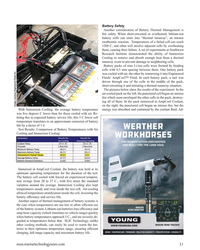 )
January 2024 - Marine Technology Reporter page: 51
)
January 2024 - Marine Technology Reporter page: 51with air, the other by immersing it into Engineered Fluids’ AmpCool™ Fluid. In each battery pack, a nail was driven through one of the cells in the middle of the pack, short-circuiting it and initiating a thermal runaway situation. The pictures below show the results of the experiment. In the air-cooled
-
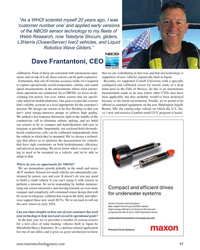 )
January 2024 - Marine Technology Reporter page: 49
)
January 2024 - Marine Technology Reporter page: 49energy-intensive pumps to achieve high quality. vy’s new and massive Lion? sh small UUV program is based. We embed a fast response thermistor right in the middle of the conductivity cell to eliminate salinity spiking, and we build our sensors to be as compact and hydrodynamic and easy to integrate as possible
-
 )
January 2024 - Marine Technology Reporter page: 4
)
January 2024 - Marine Technology Reporter page: 4Editorial bout 12 years ago I was invited to the home of then Chief of Naval Operations, Admiral Gary A Roughead, for “a discussion on unmanned underwater systems.” When I ? rst received the invite, my ? rst thought was © Jason Adelaars MBARI 2023 www.marinetechnologynews.com “how did I get on this
-
 )
January 2024 - Maritime Reporter and Engineering News page: 7
)
January 2024 - Maritime Reporter and Engineering News page: 7themselves with little time to spare. Rather than repeatedly safety and performance, improve the learner experience, and starting and stopping in the middle of a large course, a mi- reduce administrative overhead. And it brings us all closer to cro module can be completed in a short span of time and will
-
 )
January 2024 - Maritime Reporter and Engineering News page: 4
)
January 2024 - Maritime Reporter and Engineering News page: 4Authors & Contributors MARITIME REPORTER AND ENGINEERING NEWS M A R I N E L I N K . C O M ISSN-0025-3448 USPS-016-750 No. 1 Vol. 86 Maritime Reporter/Engineering News Goldberg Haun (ISSN # 0025-3448) is published monthly Galdorisi except for March, July, and October by Maritime Activity Reports, Inc.
-
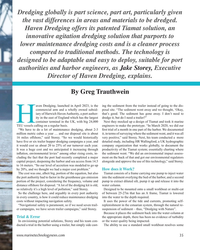 )
November 2023 - Marine Technology Reporter page: 35
)
November 2023 - Marine Technology Reporter page: 35Dredging globally is part science, part art, particularly given the vast differences in areas and materials to be dredged. Haven Dredging offers its patented Tiamat solution, an innovative agitation dredging solution that purports to lower maintenance dredging costs and is a cleaner process compared to
-
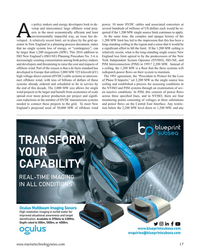 )
November 2023 - Marine Technology Reporter page: 17
)
November 2023 - Marine Technology Reporter page: 17s policy makers and energy developers look to de- power, 10 more HVDC cables and associated converters at velop and interconnect large offshore wind proj- several hundreds of millions of US dollars each would be re- ects in the most economically ef? cient and least quired if the 1,200 MW single source
-
 )
November 2023 - Marine Technology Reporter page: 14
)
November 2023 - Marine Technology Reporter page: 14readings for surfaced AUVs, risking mis- security network, and, by extension, possibly the larger port sion failure or vehicle capture. Or man-in-the-middle attacks, C2 system, is then vulnerable to attacks originating within the wherein a malicious underwater network node impersonates ROV. (Conversely
-
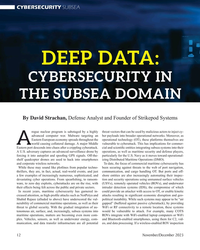 )
November 2023 - Marine Technology Reporter page: 12
)
November 2023 - Marine Technology Reporter page: 12Eastern European economy spreads throughout the operational technology (OT), these platforms themselves are A world causing collateral damage. A major Middle vulnerable to cyberattack. This has implications for commer- Eastern port descends into chaos after a crippling cyberattack. cial and scientifc entities
